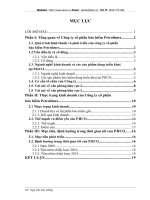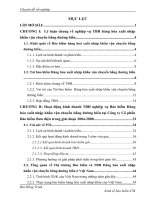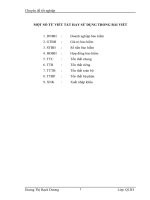Bảo hiểm hàng hóa xuất nhập khẩu
Bạn đang xem bản rút gọn của tài liệu. Xem và tải ngay bản đầy đủ của tài liệu tại đây (1.2 MB, 47 trang )
Risk Management in
Shipping
Modeling, Measuring, & Managing Freight Market
Uncertainty
Presented at:
National Technical University of Athens
School of Naval Architecture & Marine Engineering
29 May 2003
Risk Management in Shipping
Presentation Outline
Introduction
About this presentation
About FreightMetrics
About Risk Management
Defining risk
The risk management process
Scope of risk management
Modern applications of risk management
Measuring Market Risk
The traditional approach to market risk measurement
The Value-at-Risk (VaR) approach
www.freightmetrics.com
2
Risk Management in Shipping
Presentation Outline
Measuring Market Risk in Shipping
Justification for risk management in shipping
Market risk measurement vs. market forecasting
Identifying the impact of freight market risk on fleet cash flow
Developing a framework for measuring freight market risk
Measuring Market Risk in Shipping Using the Fr8Metrics TM
Methodology
Main methodological features
How does Fr8MetricsTM work?
Benefits of the Fr8MetricsTM methodology
Potential users and managerial applications
Software implementation
Managing Freight Market Risk
Altering the risk profile using managerial decisions
Altering the risk profile using freight derivatives
www.freightmetrics.com
3
Risk Management in Shipping
Introduction
About This Presentation
Our objective
Shipping is a business activity exposed to a wide variety of risks.
In this presentation we are concerned with the measurement of one particular
form of risk – namely freight market risk, or the risk of loss arising from
unexpected changes in freight rates.
Our motivation
Risk management is a notion that exists in financial markets for decades,
having experienced significant technological and modeling advances over the
years.
Shipping has proved rather slow in adopting modern risk management
techniques and best practices from other industries.
Our motivation is to present a modern framework for measuring freight
market risk, using the paradigm of other market-sensitive industries.
www.freightmetrics.com
4
Risk Management in Shipping
Introduction
About FreightMetrics
What FreightMetrics is…
A provider of consulting services and software solutions for measuring and
managing freight market risk.
Working closely with Shipping Banks, Shipowners, and Freight Traders, in order
to quantify their exposure to freight market risk in terms of cash-flow
sensitivity.
Our approach lies in transferring best practices and modern methodologies
from the area of financial risk management to shipping.
What FreightMetrics is NOT…
Shipbroker.
Forecasting agency.
Market news vendor.
Financial intermediary.
For more information about FreightMetrics, visit our website at
www.freightmetrics.com
www.freightmetrics.com
5
Risk Management in Shipping
About Risk Management
Defining Risk
Definition of Risk
We define (financial) risk as the prospect of financial loss due to unforeseen
changes in underlying “risk factors”. These risk factors are the key drivers
affecting portfolio value and financial results. Such risk factors are equity
prices, interest rates, exchange rates, commodity prices, freight rates, etc.
Types of Risks
Business:
The risk of loss due to unforeseen changes in demand,
technology,
competition, etc., affecting the
fundamentals of a business activity.
Market:
prices
Credit:
counterparty to make a
Operational:
or the
The risk of loss arising from the failures of internal systems
people who operate in them.
Other types:
Legal, Liquidity, etc.
www.freightmetrics.com
The risk of loss arising from unexpected changes in market
or market rates.
The risk of loss arising from the failure of a
promised payment.
6
Risk Management in Shipping
About Risk Management
The Risk Management Process
The Risk Management process
There is a wide misconception amongst practitioners, especially within the
shipping industry, who consider risk management as synonymous to hedging.
This is an oversimplification and does not reflect the true dimension of risk
management.
In fact, risk management is a process that involves three separate steps:
1.
Risk Modeling: Before any attempt to take decisions on risk considerations,
we must identify the underlying risk factors, understand their behavior, and try
to model their dynamics. This is the basic foundation on which the other phases
of the risk management cycle are built.
2.
Risk Measurement: After identifying and modeling the underlying risk
factors, we must determine their significance and quantify their influence on
portfolio value and financial results.
3.
Risk Management : Having identified and measured our risks, we are then
able to take informed decisions on whether to reduce our exposure or alter our
risk profile based on our risk preferences – hedging is one such alternative
course of action.
www.freightmetrics.com
7
Risk Management in Shipping
About Risk Management
Scope of Risk Management
Risk Management ≠ Hedging
As already mentioned, risk management is not synonymous to hedging.
Hedging is just one alternative for the active management of risk.
Moreover, risk management does not necessarily imply risk reduction. In fact,
the objective of risk management is NOT to reduce risk, but – more
importantly –
to quantify and control risk.
Most of the times, the objective is not to eliminate risk, but rather to alter our
risk profile according to the prevailing market conditions, our risk preferences,
and potential regulatory or contractual requirements.
Risks are embedded in any business activity. For a shipowner, the decision to
invest in a vessel signifies his belief that freight rates will go up, earning him a
return on his investment that is higher than the “risk-free” interest rate.
However, there is no “free lunch” in the economy; his decision to invest
creates at the same time a natural exposure to freight rates, accepting the
risk that freight rates may in fact go down. Risks are simply unavoidable in
any profit-taking activity.
www.freightmetrics.com
8
Risk Management in Shipping
About Risk Management
Scope of Risk Management
Uncertainty vs. Variability
1
“Variability is a phenomenon in the physical world to be measured, analysed
and where appropriate explained. By contrast, uncertainty is an aspect of
knowledge.”
Sir David Cox
Risk management is only useful for the mere fact that we cannot predict the
future. There are two components of our inability to be able to precisely
predict what the future holds: these are variability and uncertainty.
Variability is the effect of chance and is a function of the system. It is not
reducible through either study or further measurement, but may be reduced
through changing the physical system.
Uncertainty is the assessor’s lack of knowledge (level of ignorance) about the
parameters that characterize the physical system that is being modeled. It is
sometimes reducible through further study, or through consulting more
experts.
Risk management can do very little to reduce variability (markets will
continue to fluctuate no matter how advanced risk management gets), but
can be very effective in reducing uncertainty for those involved in risk-taking
decisions.
www.freightmetrics.com
9
Risk Management in Shipping
About Risk Management
Modern Applications of Risk
Management
Modern applications of Risk Management
Exposure measurement and reporting
Market risk (since early 90s)
Credit risk (since late 90s)
Operational risk (new area)
Economic capital estimation
Allocation of capital
Risk-based pricing
Risk limits
Risk-adjusted performance evaluation
www.freightmetrics.com
10
Risk Management in Shipping
About Risk Management
Modern Applications of Risk
Management
Example: Risk-Adjusted Performance Evaluation
Consider two traders who are evaluated on the basis of their realized profits at
some future date. Trader B ended up with higher profits compared to Trader A.
Does this mean he is more skilled than Trader A? Does he deserve a higher
bonus? What about the risk incurred by each trader through their trading
strategy?
www.freightmetrics.com
11
Risk Management in Shipping
Measuring Market Risk
The Traditional Approach to Risk
Measurement
The Mean-Variance framework
Under the Mean-Variance framework, we model financial risk in terms of the
mean and variance (or standard deviation, the square root of variance) of the
Profit/Loss (P&L) or the returns of our portfolio.
The Mean-Variance framework often makes the assumption that returns obey
a normal distribution (strictly speaking, the mean-variance framework does
not require normality, but it is easier to understand its statistics).
Portfolio Theory
The origin of portfolio theory can be traced back to the work of Markowitz
(1952) which earned him the Nobel prize.
Portfolio theory starts with the premise that investors choose between
portfolios on the basis of maximizing expected return for any given portfolio
standard deviation or minimizing standard deviation for any given expected
return.
One of the key insights of portfolio theory is that the risk of any individual
asset is measured by the extent to which that asset contributes to overall
portfolio risk which depends on the correlation of its return with the returns to
the other assets in the portfolio (a result known as diversification effect).
Portfolio
www.freightmetrics.com
12
theory typically makes the assumption of normally distributed
Risk Management in Shipping
Measuring Market Risk
The Value-at-Risk (VaR) Approach
The origin and development of VaR
In the late 70s and 80s, a number of major financial institutions started
working on internal models to measure and aggregate risks across the
institution as a whole.
The best known of these models is the RiskMetrics model developed by JP
Morgan. According to industry legend, this model is said to have originated
when the chairman of JP Morgan, Dennis Weatherstone, asked his staff to give
him a daily one-page report – the famous “4:15 report” – indicating risk and
potential losses over the next 24 hours, across the bank’s entire trading
portfolio.
The report was ready by around 1990 and the measure used was Value-atRisk (VaR), or the maximum likely loss over the next trading day. VaR was
estimated from a system based on standard portfolio theory, using estimates
of the standard deviations and correlations between the returns of different
traded instruments.
In early 1994, JP Morgan set up the RiskMetrics unit to make its data and basic
methodology available to outside parties. This bold move attracted a lot of
attention and raised awareness of VaR techniques and risk management
systems.
The subsequent adoption of VaR systems was very rapid, first among
securities houses and investment banks, and then among commercial banks,
www.freightmetrics.com
other financial institutions and non-financial corporates.
13
Risk Management in Shipping
Measuring Market Risk
The Value-at-Risk (VaR) Approach
VaR in practice
VaR Basics:
www.freightmetrics.com
VaR on a portfolio is the maximum loss we might expect over a given
holding or horizon period, at a given level of confidence (probability).
VaR is less restrictive on the choice of the distribution of returns and
the focus is on the tail of that distribution – the worst p percent of
outcomes.
14
Risk Management in Shipping
Measuring Market Risk
The Value-at-Risk (VaR) Approach
VaR in practice
Estimating VaR: The various methodologies for estimating VaR actually
differ on their particular technique for constructing the distribution of possible
portfolio values from which VaR is inferred. The most common methodologies
are:
Analytical methods (Variance/Covariance)
Historical simulation
Monte-Carlo simulation
Attractions of VaR:
VaR is a single, summary, statistical measure of possible portfolio
losses, providing a common and consistent measure of risk across
different positions and risk factors.
It takes account of the correlations between different risk factors.
It is fairly straightforward to understand, even for non-technical
people.
VaR variants: Following the same logic, other “at risk” measures have
been proposed to quantify risk in various settings: Cash Flow at Risk (CaR),
www.freightmetrics.com
Earnings at Risk (EaR), etc.
15
Risk Management in Shipping
Measuring Market Risk in Shipping
Justification for Risk Management in
Shipping
Business and market risk in shipping: the two faces of the
same coin
Most industries can distinguish between business risks and market risks.
These industries have to worry about business risks and try to hedge away
market risks which may have an adverse side-effect on financial results. For
example, an auto manufacturer has to worry about business risks such as
technology, competition, production, R&D, but may also have an exposure to
FX risk, which may hamper exports, or interest rate exposure which may
increase debt service on floating rate obligations.
Other industries cannot distinguish between business risks and market risks.
The most pronounced example is maybe that of financial institutions. A
significant part of the business of financial institutions is to take direct
exposure in the world’s equity, interest rate, currency, and commodity
markets.
Shipping can be said to belong to the industries that cannot distinguish
between business risks and market risks. Financial results in shipping are
directly affected by movements in the world’s freight rate markets.
Shipowners are in effect in the business of managing shipping risk
affecting a portfolio of physical assets, rather than simply managing
a fleet of vessels.
www.freightmetrics.com
16
Risk Management in Shipping
Measuring Market Risk in Shipping
Justification for Risk Management in
Shipping
High market volatility
Freight rates have historically been very volatile. The impact of unforeseen
geo-political events and the slow speed of adjusting supply to demand have
often resulted in dramatic fluctuations in the level of freight rates.
Example of Freight Market Fluctuations
BFI
(Baltic Freight Index, BCI Route 2, BPI Route 1)
BCIr2
Standardised scaling (base=100 @1/3/99)
BPIr1
300
250
200
150
100
50
0
1/4/1985
www.freightmetrics.com
1/4/1987
1/4/1989
1/4/1991
1/4/1993
17
1/4/1995
1/4/1997
1/4/1999
1/4/2001
1/4/2003
Risk Management in Shipping
Measuring Market Risk in Shipping
Justification for Risk Management in
Shipping
Industry inefficiencies
Capital needs vs. sources of funds:
Shipping is a capital intensive industry with significant funding needs
for fleet expansion and replacement purposes. Yet, it has very limited
opportunities to diversify its sources of funding, as most of its
financing comes in the form of bank debt.
Asset – Liability (mis)matching
Asset economic life >> term of debt financing
Variable (uncertain) revenues to meet fixed debt claims
Pro-cyclical lending practices
www.freightmetrics.com
Many banks tend to be influenced by the general sentiment of the
market and ignore the cyclical nature of the business. Thus, they
appear more willing to lend when the market (and vessel prices) is
high, despite the fact that the market will eventually revert back to
lower levels. In contrast, they appear rather hesitant to extend credit
at a period of low freight rates, although they are likely to rise to more
sustainable levels.
18
Risk Management in Shipping
Measuring Market Risk in Shipping
Justification for Risk Management in
Shipping
Lessons from the High Yield disaster of the late 90s
In the late 90s, many shipping companies decided to tap the public debt
markets with high-yield bonds. Historically, it was the first massive attempt of
the industry to diversify away from bank debt, using an alternative source of
external funding.
Unfortunately, nearly all of these high yield issues subsequently defaulted,
mainly due to insufficient cash flow generation.
This indicated poor risk assessment and a lack of appropriate tools to
evaluate shipping market risks.
Example:
Source: Moody’s (2002)
www.freightmetrics.com
19
Risk Management in Shipping
Measuring Market Risk in Shipping
Justification for Risk Management in
Shipping
Lessons from the High Yield disaster of the late 90s
Examples:
Source: Moody’s (2002)
www.freightmetrics.com
20
Risk Management in Shipping
Measuring Market Risk in Shipping
Market Risk Measurement vs. Market
Forecasting
Types of maritime forecasting
Structural econometric models: Model freight rates as a dependent
variable, driven by a number of independent variables, usually representing
macro-economic factors that influence shipping demand, e.g. GDP growth, oil
prices, industrial output, etc.
Time series models: Model freight rates using the structure (serial
correlation) in the past history of the data itself. Future freight rates are
determined based on lagged values of their own history and do not exploit or
infer causality with other economic variables.
Difficulties in maritime
forecasting
Demand for shipping is characterized as
derived demand, meaning that it
depends on the demand of the
commodities that are shipped by sea.
Econometric models are prone to
specification problems. Model fit can
always improve by including more
explanatory variables, which may
introduce multicollinearity problems.
It is possible that a small error in
www.freightmetrics.com
21
Risk Management in Shipping
Measuring Market Risk in Shipping
Market Risk Measurement vs. Market
Forecasting
Differences in scope
Scope:
Motivation:
market)
Prevent unexpected losses vs. Make a profit (beat the
Horizon:
Long-term vs. Short-term
Emphasis:
Tail of the distribution vs. Mean of the distribution
Prepare for future vs. Predict the future
Differences in methodology
Measurement does not presuppose causality relations between economic
variables.
Forecasting models have potentially infinite specifications (depending on
choice of explanatory variables).
Measurement focuses on producing the complete picture of potential
outcomes (entire distribution) rather than producing a point estimate (the
mean of the distribution).
So, do we discard forecasting? NO, it can serve a useful complementary role,
especially in revealing causality relations between economic variables.
www.freightmetrics.com
Forecasting may also assist in certain chartering or trading decisions in the
22
Risk Management in Shipping
Measuring Market Risk in Shipping
Impact of Freight Rate Volatility on
Cash Flow
Identifying the impact of freight rate volatility on fleet
cash flow
Fluctuations in freight rates directly affect fleet cash flow.
Cash flow performance is the topmost concern in shipping.
Ship financing belongs to the family of “Project Financing” (other forms of
project financing include airlines, infrastructure, real estate, etc.). There is a
principle in project financing: repayment MUST come from the operating cash
flows of the financed asset.
So, what really matters in measuring freight market risk is the impact of
freight rate variability on cash flow performance.
Case study
We performed a simple exercise (historical simulation) of the cash flow
generation of a handysize dry bulker over two separate time periods (period
A: Jan-1980 to Dec-1986, and period B: Jan-1987 to Dec-1993).
We used the same set of assumptions in both cases (see the following slide),
except for using the actual freight rates for each period and the actual
second-hand value of the financed vessel at the start of the each period.
This exercise not only illustrates the impact of freight rate volatility on cash
www.freightmetrics.com
23
Risk Management in Shipping
Measuring Market Risk in Shipping
Impact of Freight Rate Volatility on
Cash Flow
Case study: impact of freight rate volatility on fleet cash
flow
Historical simulation assumptions and actual freight rate data (source:
Clarksons)
1-yr time charter rate for Handysize (30000 dwt)
ASSUMPTIONS
Operating
Rev. days
Opex days
Opex ($/day)
Loan
Vessel value
Loan amount
Advance ratio
Installments
Balloon
Loan interest
Start. Liquidity Cash balance
PERIOD
A (80-86)
B (87-93)
25
25
30
30
3,500
3,500
10,000,000
3,800,000
7,000,000
2,660,000
70%
70%
84
84
30%
30%
5%
5%
0
0
Period A: Jan80-Dec86
12000
Period B: Jan87-Dec93
10000
8000
($/day)
6000
4000
2000
www.freightmetrics.com
24
Jan-99
Jan-98
Jan-97
Jan-96
Jan-95
Jan-94
Jan-93
Jan-92
Jan-91
Jan-90
Jan-89
Jan-88
Jan-87
Jan-86
Jan-85
Jan-84
Jan-83
Jan-82
Jan-81
Jan-80
Jan-79
Jan-78
Jan-77
Jan-76
0
Risk Management in Shipping
Measuring Market Risk in Shipping
Impact of Freight Rate Volatility on
Cash Flow
Case study: impact of freight rate volatility on fleet cash
flow
Chart of monthly net cash flow (after debt service, but excluding
balloon
A (80-86)
Impact of freight rate volatility on fleet cash flow
payment):
B (87-93)
150,000
Monthly Net Cash Flow ($)
100,000
50,000
0
4
8
12
16
20
24
28
32
36
40
44
-50,000
-100,000
-150,000
Month
www.freightmetrics.com
25
48
52
56
60
64
68
72
76
80
84









